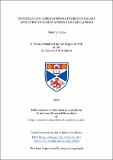Files in this item
Investigating observational probes of galaxy evolution in observations and simulations
Item metadata
| dc.contributor.advisor | Tojeiro, Rita | |
| dc.contributor.author | Bates, Dominic | |
| dc.coverage.spatial | xix, 123 p, | en_US |
| dc.date.accessioned | 2023-02-08T15:34:19Z | |
| dc.date.available | 2023-02-08T15:34:19Z | |
| dc.date.issued | 2022-06-22 | |
| dc.identifier.uri | https://hdl.handle.net/10023/26922 | |
| dc.description.abstract | In this thesis, we perform tests of galaxy evolution using a number of different observational probes. In chapter 2, we implement a method of obtaining redshift distributions for photometric samples of galaxies, known as clustering redshifts. We test this on real data from the Baryon Oscillation Spectroscopic Survey (BOSS), and simulated data from semi-analytic models, showing that assumptions about the bias evolution of the unknown sample can become important for some samples of galaxies, particularly at faint magnitudes. We also find that the choice of clustering scale makes a big difference to the noise in the recovered redshift distribution. In chapter 3, we apply the clustering redshifts method to data from the Sloan Digital Sky Survey (SDSS), recovering redshift distributions as a function of colour, allowing us to compute mass and luminosity functions over large volumes. Little evolution is seen in our recovered mass function between 0.2 < z < 0.8, implying the most massive galaxies form most of their mass before z = 0.8. These mass functions are used to produce stellar mass completeness estimates for BOSS, giving a completeness of 80% above M[sub]⋆ > 10[super](11.4) M[sub]☉︎ between 0.2 < z < 0.7, with completeness falling significantly at higher redshifts and lower masses. In chapter 4, we go on to investigate how well the formation history of a dark matter halo can be inferred in simulations from the observable properties of a galaxy, finding that applying a machine learning approach considering multiple properties performs significantly better than using individual properties. We add errors to parameters, finding that a machine learning approach still performs best, and finally use this approach to compute formation times for the GAMA survey. We investigate how formation time changes with environment at fixed mass, finding signs of assembly bias, with high mass halos in dense environments being younger than those in under-dense regions, and the trend reversing at lower halo masses, with halos in dense environments being older. | en_US |
| dc.language.iso | en | en_US |
| dc.publisher | University of St Andrews | en |
| dc.subject.lcc | QB857.5E96B2 | |
| dc.subject.lcsh | Galaxies--Evolution | en |
| dc.subject.lcsh | Astronomy--Observations | en |
| dc.title | Investigating observational probes of galaxy evolution in observations and simulations | en_US |
| dc.type | Thesis | en_US |
| dc.contributor.sponsor | Science and Technology Facilities Council (STFC) | en_US |
| dc.type.qualificationlevel | Doctoral | en_US |
| dc.type.qualificationname | PhD Doctor of Philosophy | en_US |
| dc.publisher.institution | The University of St Andrews | en_US |
| dc.identifier.doi | https://doi.org/10.17630/sta/267 |
This item appears in the following Collection(s)
Items in the St Andrews Research Repository are protected by copyright, with all rights reserved, unless otherwise indicated.

